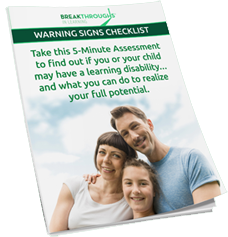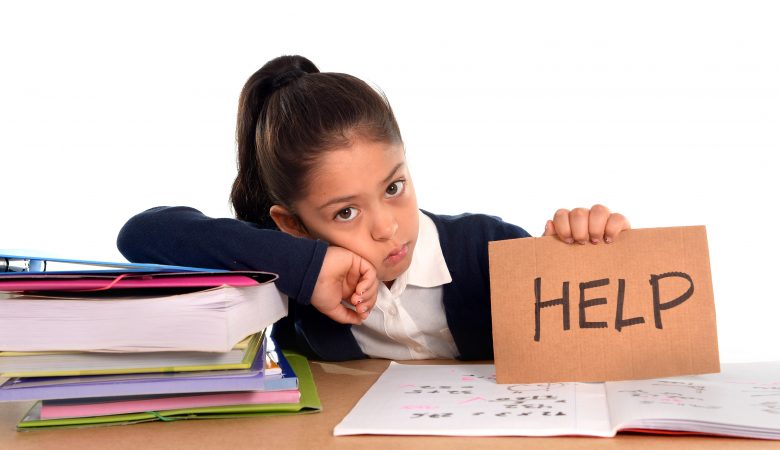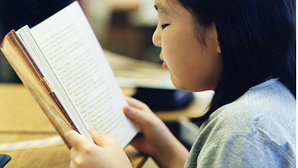
Does it affect life at home, at school or at work?
Take 5 minutes to complete the Warning Signs Checklist and discover whether you or your child could have learning difficulties that are impacting your life, and what to do about it.
Take The Free Warning Signs Checklist!
A recent survey by Canadian Living Magazine (May 2012) of Ontario’s grade 6 students revealed that ½ of them don’t like to read. Reading was always an area of strength for me, but I have worked with many children who struggle with reading for a wide variety of reasons. I believe that if you are good at something, then in most cases you will enjoy it. For 50% of grade 6 students to not enjoy reading there is something seriously wrong.
One of the most common challenges I see in the children and adults I work with is poor eye tracking. Eye tracking is the ability for both eyes to work as a team and follow across a line of print. Many different types of reading disabilities involve poor eye tracking. While this seems a simple and ordinary part of life we take for granted, many people experience this daily.
 One of the symptoms of weak eye tracking is jumpy eyes. These people will miss small words when reading. Their eyes will skip right over the shorter words. Parents often tell me “My child keeps missing small words. How can you miss reading ‘the’ or ‘of’?” Another Interesting symptom is when a word is misread. This often surfaces as the parent or teacher thinks the child is guessing at the word. “They read the first part of the word right and just guess at the rest.” If Stephanie’s eye tracking scan width is the equivalent of 4 letters, when she sees the word ‘reading’ her eyes will scan the first 4 letters ‘read’. Her peripheral vision will indicate that there is more to the word and often her brain will unconsciously substitute a random suffix. In this case Stephanie may see the word ‘reading’ instead of the actual word ‘ready’. This leads to confusion, and very poor reading comprehension as misreading words can have a snowball effect on our understanding of what we’re reading.
One of the symptoms of weak eye tracking is jumpy eyes. These people will miss small words when reading. Their eyes will skip right over the shorter words. Parents often tell me “My child keeps missing small words. How can you miss reading ‘the’ or ‘of’?” Another Interesting symptom is when a word is misread. This often surfaces as the parent or teacher thinks the child is guessing at the word. “They read the first part of the word right and just guess at the rest.” If Stephanie’s eye tracking scan width is the equivalent of 4 letters, when she sees the word ‘reading’ her eyes will scan the first 4 letters ‘read’. Her peripheral vision will indicate that there is more to the word and often her brain will unconsciously substitute a random suffix. In this case Stephanie may see the word ‘reading’ instead of the actual word ‘ready’. This leads to confusion, and very poor reading comprehension as misreading words can have a snowball effect on our understanding of what we’re reading.
A dramatic area where jumpy eyes can affect reading is when eye tracking is poor enough the reader jumps from one line to another. This occurs when we lose track of where we were reading and find our eyes on some other part of the page. If reading comprehension is poor enough, the reader may not even realize it has happened and continue reading. Upon completion of the reading assignment these readers will often be confused or have no idea what they read.

We all will at times lose our place while reading, especially when our eyes are strained, at the end of the day or in poor lighting. Readers with ‘jumpy eyes’ however experience it on an ongoing basis regardless of the circumstances. Interestingly only approximately 50% of people with poor eye tracking are conscious of it. I’ve assessed people with poor eye tracking who swear their eyes don’t jump and they have no idea what I’m talking about. They are completely shocked when I show them a video of their eyes attempting to track, and instead jumping all over the place.
There are a number of things that can be done to develop and improve eye tracking that we do every day at Breakthroughs. Reading is an important part of everyday life and an integral part of learning. The easier it is to read, the easier learning will be. Reading is a strength for me, and so studying for exams took me far less time than my classmates. With the right tools reading can become a strength for you or your child as well.
Subscribe to our newsletter and receive regular articles and resources to help you or your child perform better at school, home or work.
suscribe now
Post Your Comment Below